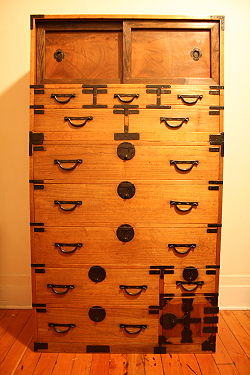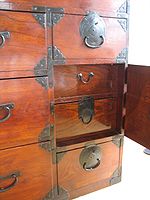
Tansu
Encyclopedia

Chest (furniture)
A chest is one of the oldest forms of furniture. It is typically a rectangular structure with four walls and a liftable lid, for storage. The interior space may be subdivided...
, chest of drawers
Chest of drawers
A chest of drawers, also called a dresser or a bureau, is a piece of furniture that has multiple parallel, horizontal drawers stacked one above another...
or cupboard
Cupboard
A cupboard or press is a type of cabinet, often made of wood, used indoors to store household objects such as food, crockery, textiles and liquor, and protect them from dust,vermin and dirt....
in Japanese. It is often used in the West to refer to traditional Japanese chests, handcrafted and made of fine woods, such as Hinoki (Japanese cypress)
Chamaecyparis obtusa
Chamaecyparis obtusa is a species of cypress native to central Japan.It is a slow-growing tree which grows to 35 m tall with a trunk up to 1 m in diameter. The bark is dark red-brown...
, Keyaki (Japanese elm)
Zelkova serrata
Zelkova serrata is a species of Zelkova native to Japan, Korea, eastern China, and Taiwan. It is often grown as an ornamental tree, and used in bonsai.-Description:...
, Kuri (Japanese chestnut)
Japanese Chestnut
Japanese Chestnut is a species of chestnut originally native to Japan and South Korea. It is a small to medium-sized deciduous tree growing to 10-15 m tall. The leaves are similar to those of the Sweet Chestnut, though usually a little smaller, 8-19 cm long and 3-5 cm broad...
, Sugi (Japanese cedar)
Cryptomeria
Cryptomeria is a monotypic genus of conifer in the cypress family Cupressaceae formerly belonging to the family Taxodiaceae; it includes only one species, Cryptomeria japonica . It is endemic to Japan, where it is known as Sugi...
and Kiri (Paulownia)
Paulownia tomentosa
Paulownia tomentosa is a deciduous tree in the genus Paulownia, native to central and western China, but invasive in the US...
.
Many collectors focus on finding antique Tansu. There are many workshops producing Tansu in imitation of the classic antiques. Some are made of excellent reclaimed wood
Reclaimed lumber
Reclaimed lumber is wood taken for re-use. Most reclaimed lumber comes from timbers and decking rescued from old barns, factories and warehouses although some companies use wood from less traditional structures such as boxcars, coal mines and wine barrels...
, causing the new Tansu to retain a more aged look that some people seek.
Types of tansu
- Choba-dansu Were used by Chonin - Merchants, these chests display elaborate metal hardware, and were traditionally used in shops to impress customers. These chests do come in many sizes, serving everything from storage for sewing supplies, sea chests, merchant chests, and up to large ones for storage of futons and kitchen equipment. Sometimes these chests open only on a single side, but others are notable for being accessible from both sides, leading to quite a wide variety of options in interior design.
- Kusuri-dansu are apothecary chest. They were used to store herbs which would be made into prescriptions by the pharmacist. They are often made of Kiri wood and have many small drawers.
- The Kaidan-dansu (or step-chests as they are sometimes called) were often designed in several modular pieces. This was used to avoid taxation on other areas of a home when taxes were levied based on the size of ones home. When the tax collectors were coming around the chest that functioned as stairs up to a separate level could be moved so that their function could be hidden.
- Katana-dansu were used to store swords. These chests were long and low and owned by SamuraiSamuraiis the term for the military nobility of pre-industrial Japan. According to translator William Scott Wilson: "In Chinese, the character 侍 was originally a verb meaning to wait upon or accompany a person in the upper ranks of society, and this is also true of the original term in Japanese, saburau...
families. Quite often the wood used in these chests was Kiri because it kept swords from rusting in the humid Japanese summers.
- Mizuya-dansu or daidokoro-dana were used in kitchens for the storage of plates, utensils and food items. Most kitchen chests will not have locks and will be a combination of sliding doors and drawers.
- Sendai-dansu are chests used to store kimonoKimonoThe is a Japanese traditional garment worn by men, women and children. The word "kimono", which literally means a "thing to wear" , has come to denote these full-length robes...
and clothing. They originated from craftsmen in the Sendai region, and are often made of zelkovaZelkovaZelkova is a genus of six species of deciduous trees in the elm family Ulmaceae, native to southern Europe, and southwest and eastern Asia. They vary in size from shrubs to large trees up to 35 m tall . The leaves are alternate, with serrated margins, and a symmetrical base to the leaf blade...
wood with drawers lined in cedar. Sendai-dansu are characterised by one long top drawer, with three slightly smaller drawers underneath. There is usually a lockable door containing two smaller drawers. Sendai-dansu are known for their elaborate ironwork - commissioned from former sword makers after the SamuraiSamuraiis the term for the military nobility of pre-industrial Japan. According to translator William Scott Wilson: "In Chinese, the character 侍 was originally a verb meaning to wait upon or accompany a person in the upper ranks of society, and this is also true of the original term in Japanese, saburau...
were disbanded in the MeijiMeiji periodThe , also known as the Meiji era, is a Japanese era which extended from September 1868 through July 1912. This period represents the first half of the Empire of Japan.- Meiji Restoration and the emperor :...
era.
- Kuruma-dansu are any chest with wheels. Fire was a major hazard in the Edo periodEdo periodThe , or , is a division of Japanese history which was ruled by the shoguns of the Tokugawa family, running from 1603 to 1868. The political entity of this period was the Tokugawa shogunate....
. Early in the Edo era the most valuable items from a family or business were stored in a wheeled chest that was pulled outside when the home or business caught fire. The earliest style was Karuma-nagamochi or long trunk on wheels. As a result of the role these chests played in the great number of deaths in the Meireiki fire in Edo in 1657 this style of tansu was forbidden in Edo, Osaka, and Kyoto. Later more specific styles were developed for specific uses and regionally.
- Cha-dansu were used to store tea ceremony implements. Because the tea ceremonyTea ceremonyA tea ceremony is a ritualised form of making tea. The term generally refers to either chayi Chinese tea ceremony, chado Japanese tea ceremony, tarye Korean tea ceremony. The Japanese tea ceremony is more well known, and was influenced by the Chinese tea ceremony during ancient and medieval times....
was important these chests were often left inside the home to act as both a storage and display cabinet. For this reason most are made of finely figured woods.
- Funa-dansu, literally "ship chests", were used as shipping containers from the Edo period into the Meiji Era. These came in three basic designs:
- kakesuzuri - a small chest with a single swinging door, with multiple internal drawers inside
- hangai - literally "half hitsu" (coffer), a small chest used for clothing storage. Often made in sets of two, with one stacked above the other.
- cho-bako - "account box", which had many forms, but could include:
- kendon-buta - a drop-fit door cut into the case, used to hide a money box
- kobiraki-do - a small swinging door in the lower-right corner
- ryobiraki-do - double doors with half-faced hinges on the lower half of the box
- dezura hikidashi - one or two drawers, exposed to the exterior
- hiki-do - removable double sliding doors, running the full width of the box, appearing on the top third or middle third of the box
- zuri-do - removable single sliding door in the lower half of the box, in the lower-left. Typically appears with a kobiraki-do
Regional types


Types of hardware
The elements of antique tansu hardware were created from forged iron, with on some occasions copper being used. The flat pieces were chiseled from forged iron plates and subsequent design elements engraved or inlaid. The black finish on the iron was created by applying rapeseedRapeseed
Rapeseed , also known as rape, oilseed rape, rapa, rappi, rapaseed is a bright yellow flowering member of the family Brassicaceae...
oil to the hot metal.
- herikanagu - edge hardware, lining the edges and corners of a tansu
- obikanagu - "sash hardware" which spans a face of the tansu, such as the top, or the face of a cabinet door
- sumikanagu - drawer or drawer-corner hardware, appearing at the corners of drawer faces. Generally these match their associated edge hardware.
- mochiokuri - a carrying handle, generally a loop appearing on the side near the top
- sao-toshi - a different type of carrying loop, usually sliding, which was designed to hold a pole when used with its mate on the other side
- meita - a lock jamb plate
- jomae - a lock plate, a metal, lockable plate affixed to a drawer face
- sashikomijo - a sliding-door lock
- bo - a vertical locking bar
- hikite - drawer pullDrawer pullA drawer pull or simply pull is a handle to pull a drawer out of a chest or other furniture piece.A drawer pull often consists of a plate to which a handle is fastened. The handle may swing from one or two points , making a drop drawer pull. The handle may also be fastened to the plate with...
- zagane - an "escutcheon," or flange, surrounding the contact point of a drawer pull
- toshi-zagane - a back plate for a drawer pull
- choban - hinge
- kasugai - a staple affixing hardware to the wood
- jomon - family crest, identifying the merchant
- yago - a trademark, identifying the merchant
Additional reading
- Japanese Cabinetry - the art and craft of Tansu by David Jackson and Dane Owen, Gibbs-Smith Publisher 2002
External links
- Kateigaho - Article detailing many features of Tansu
- Stanford JGuide - Crafts & Antiques section -(Many links to informational sources on Tansu and related topics)

